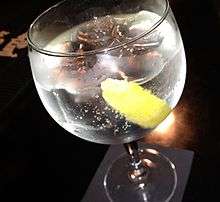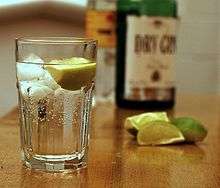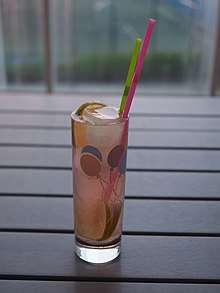Gin and tonic
A gin and tonic is a highball cocktail made with gin and tonic water poured over a large amount of ice.[1] The ratio of gin to tonic varies according to taste, strength of the gin, other drink mixers being added, etc., with most recipes calling for between a 1:1 to 1:3 ratio. It is usually garnished with a slice or wedge of lime. To preserve effervescence, the tonic can be poured down a bar spoon.[2] The ice cools the gin, dulling the effect of the alcohol in the mouth and making the drink more pleasant to taste.[3]

| Cocktail | |
|---|---|
 Gin and tonic with lime wedge | |
| Type | Mixed drink |
| Primary alcohol by volume | |
| Served | Poured over ice cubes (on the rocks) |
| Standard garnish | A slice or wedge of lime |
| Standard drinkware | Highball glass or rocks glass |
| Commonly used ingredients | Gin and tonic water, according to taste |
| Preparation | In a glass filled with ice cubes, add gin and tonic. |
In some countries (e.g. UK), gin and tonic is also marketed pre-mixed in single-serving cans.[4] In the United States, most bars use "soda out of a gun that in no way, shape, or form resembles quinine water", according to bartender Dale DeGroff.[5] To get a real gin and tonic, DeGroff recommends specifying bottled tonic.[5] Alternatively, one can add tonic syrup to soda water.[6]

It is commonly referred to as a "G and T" in the UK, US, Canada, Australia, New Zealand and Ireland.[7] In some parts of the world, it is called a "gin tonic" (e.g. in Germany, Italy, France, Japan ( ジン・トニック, phonetically "jin tonikku"), the Netherlands, Spain, Turkey).
Garnish
Gin and tonic is traditionally garnished with a slice or wedge of lime, often slightly squeezed into the drink before being placed in the glass. In most parts of the world lime remains the only usual garnish; however, lemon is often used as an alternative fruit. In the United Kingdom, the use of both lemon and lime together is known as an "Evans".[8] Although the origins of the use of lemons are unknown, their use dates back at least as far as the late 1930s.[9] In addition lemons are often more readily available, and cheaper to purchase, than limes. The use of lemon or lime is a debated issue[10] – some leading brands, such as Gordon's,[11] Tanqueray,[12] and Bombay Sapphire,[13] recommend the use of lime in their gin.
History
The cocktail was introduced by the army of the British East India Company in India. In India and other tropical regions, malaria was a persistent problem. In the 1700s Scottish doctor George Cleghorn studied how quinine, a traditional cure for malaria,[14] could be used to prevent the disease.[15] The quinine was drunk in tonic water, however the bitter taste was unpleasant.[15] British officers in India in the early 19th century took to adding a mixture of water, sugar, lime and gin to the quinine in order to make the drink more palatable, thus gin and tonic was born.[16] Soldiers in India were already given a gin ration, and the sweet concoction made sense.[17] Since it is no longer used as an antimalarial, tonic water today contains much less quinine, is usually sweetened, and is consequently much less bitter.[18]
Gin and tonic is a popular cocktail during the summer.[19] A 2004 study found that after 12 hours, "considerable quantities (500 to 1,000 ml) of tonic water may, for a short period of time, lead to quinine plasma levels at the lower limit of therapeutic efficacy and may, in fact, cause transitory suppression of parasites". This method of consumption of quinine was impractical for malaria prophylaxis, as the amount of drug needed "can not be maintained with even large amounts of tonic". The authors conclude that it is not an effective form of treatment for malaria.[20]
Variations

Mixers can include lime juice,[21] lemon juice,[22] orange juice and spiced simple syrup,[23] grenadine,[24] tea,[25] etc.
Besides the classic lime wheel, garnishes can include, for example, orange peel, star anise, thyme-elderflower, a slice of ginger, pink grapefruit and rosemary, cucumber, mint and black peppercorns, strawberry and basil, strawberry syrup,[26][27] chillies and lime, etc.[1] Fruits such as kumquats or other citrus or cucumber[28] can be muddled in it.[29] A gin and tonic can also be mixed with a sorbet.[30]
Some gin-and-tonic inspired drinks also have champagne (e.g. the Parisian), vermouth and Campari (e.g. the Sbagliato-nic), vermouth and bitters (e.g. the Posh G&T), super smokey whiskey (e.g. the Ol' Smokey), peach liqueur and grapefruit bitters (e.g. the Tonic Delight), mint bitters and chocolate liqueur (e.g. the Guilty Pleasure), etc.[31]
Spanish variations

In Spain, a variation on the drink called Gin-Tonic has become popular. This differs from a traditional gin and tonic as it is served in a balloon glass (copa de balon)[32] or coupe glass with plenty of ice and a garnish tailored to the flavours of the gin. The drink could be fruit-based but the use of herbs and vegetables, reflecting the gin's botanicals, is increasingly popular.[33] The balloon glass is used because the aromas of the drink can gather at its opening for the drinker to more easily appreciate.[34]
The popularity of this variation of the gin and tonic has led to the establishment of Gin-Tonic bars, in which customers can choose their preferred gin, tonic, and garnish from a menu.[35]
In popular culture
The transgalactic nature of the gin and tonic is imagined in Douglas Adams' novel The Restaurant at the End of the Universe, which describes how "85% of all known worlds in the Galaxy, be they primitive or highly advanced, have invented a drink called jynnan tonnyx, or gee-N'N-T'N-ix, or jinond-o-nicks, or any one of a thousand or more variations on the same phonetic theme. The drinks themselves are not the same, and vary between the Sivolvian 'chinanto/mnigs' which is ordinary water served at slightly above room temperature, and the Gagrakackan 'tzjin-anthony-ks' which kills cows at a hundred paces; and in fact the one common factor between all of them, beyond the fact that the names sound the same, is that they were all invented and named before the worlds concerned made contact with any other worlds."
James Bond specifies a recipe for a gin and tonic while in Kingston, Jamaica, in the book Dr. No. Unusually it involves the juice of a whole lime.[36]
The first character described in the Billy Joel song "Piano Man" is said to be "making love to his tonic and gin."
The song "Supersonic" by English rock band Oasis references the drink.
In the movie The Year of Living Dangerously, Colonel Henderson, when he first meets Guy Hamilton, complains when his gin and tonic is served with ice, explaining that only Americans drink it like that.
On the sitcom How I Met Your Mother, character Barney Stinson played by Neil Patrick Harris is often heard ordering a gin and tonic. On one occasion where he serves as a bartender, the audience learns that he does not know what the drink consists of.
Gin and tonic is one of John Constantine's drinks of choice in the Hellblazer comics. Gin and tonic is also the drink of choice for hero, Cat, in Jeaniene Frost's Night Huntress Series.
Founded in 2010, International Gin & Tonic Day is celebrated worldwide on 19 October.[37]
Melanie Scrofano's character, Mrs. McMurray, prefers to drink gin and tonics in the Canadian TV comedy Letterkenny.
See also
- Dubonnet, another drink invented to encourage European colonial soldiers in tropical climates to take quinine
- Lillet, an aperitif wine
- Pink Gin, Plymouth gin mixed with Angostura bitters
- Quinquina, a quinine-containing beverage sometimes used as a mixer with gin
- Beton, a cocktail made by mixing tonic water with Becherovka, a Czech bitters[38]
References
- https://www.goodhousekeeping.com/uk/food/a561150/how-to-make-perfect-gin-and-tonic/
- Bombay Sapphire Global (18 July 2017). "03 Ultimate G&T 1". YouTube.
- https://www.goodhousekeeping.com/uk/food/a569222/gin-and-tonic-mistakes/
- "Greenall's Gin & Tonic 250ml product information". Tesco.com. Archived from the original on 28 September 2011. Retrieved 2 June 2010.
- Jon Bonné (8 February 2006). "Secrets to a perfect gin and tonic". MSNBC. Archived from the original on 5 August 2006. Retrieved 2 June 2010.
- Sintumuang, Kevin (13 August 2011). "Build a Better Gin and Tonic | Half Full - WSJ". online.wsj.com. Retrieved 25 June 2014.
- "G and T". Oxford Dictionaries. April 2010. Oxford University Press. 6 December 2010.
- Knoll, A & Smith, D (2013). The Craft of Gin. Hayward: White Mule Press. p.69. ISBN 978-0-983-63896-4.
- "Gin and Tonic as served at the Shepheard's in Cairo" Gilbey's Gin advert from Punch magazine, April 1938
- Simonson, Robert; DeSantis, Alicia (22 May 2013). "How Would You Like Your Drink?". New York Times.
- "Gordon's Perfect G&T". Gordon's. Retrieved 1 January 2019.
- "Tanqueray London Dry Gin & Tonic". Tanqueray. Retrieved 1 January 2019.
- "Bombay Sapphire and Tonic Recipe". Bombay Sapphire. Retrieved 1 January 2019.
- The Malaria Site. Retrieved 18 August 2019.
- "From Charles Mackintosh's waterproof to Dolly the sheep: 43 innovations Scotland has given the world". The independent. 30 December 2016.
- Tonic water: sweet, bitter medicine. Retrieved 30 December 2009.
- Raustiala, Kal (28 August 2013). "Gin and tonic kept the British Empire healthy: The drink's quinine powder was vital for stopping the spread of malaria". Slate.com. Retrieved 25 June 2014.
- Burkhart, Jeff (2010). "Do you know where your New Year's cocktail comes from?". National Geographic Assignment. Archived from the original on 24 April 2011. Retrieved 1 December 2010.
- Hughes, Christopher (25 June 2013). "Gin Dandy: Three Tonic Syrups for Your Summer G & T". Boston Magazine.
- C. G. Meyer; et al. (December 2004). "Editorial: Gin tonic revisited". Trop Med Int Health. 9 (12). doi:10.1111/j.1365-3156.2004.01357.x. PMID 15598254.
- https://cooking.nytimes.com/recipes/6420-gin-and-tonic
- https://vinepair.com/wine-blog/the-navy-strength-botanical-gin-tonic-recipe/
- https://vinepair.com/cocktail-recipe/winter-gin-tonic-recipe/
- https://vinepair.com/cocktail-recipe/the-pomegranate-gin-tonic-recipe/
- https://vinepair.com/cocktail-recipe/breakfast-tonic-recipe/
- https://www.afarmgirlsdabbles.com/strawberry-gin-and-tonic/
- https://simply-delicious-food.com/blushing-strawberry-gin-and-tonic/
- https://vinepair.com/articles/the-gtc-recipe-gin-tonic/
- https://minimalistbaker.com/all-natural-gin-and-tonics/
- https://vinepair.com/wine-blog/gin-and-tonic-sorbet-recipe/
- https://www.bbcgoodfood.com/howto/guide/10-gin-and-tonics-twist
- "Bombay Pushes Gin-trend with glassware". thedrinksbusiness.com. Retrieved 9 January 2012.
- "The 8 Great Gins of London Gin Club". Archived from the original on 21 September 2013. Retrieved 15 August 2012.
- "World Gin Day Gin Tonica Tasting". SummerFruitCup.com. Retrieved 6 July 2012.
- "Spain's Gin And Tonic Bars". foodrepublic.com. Retrieved 6 July 2012.
- "The James Bond Gin & Tonic". tjbd.co.uk. Retrieved 11 August 2012.
- "International Gin & Tonic Day - 10/19/2013". liquor.com. Archived from the original on 20 October 2013. Retrieved 19 October 2013.
- "Not Sure What to Do with Becherovka? Try This". Liquor.com. Retrieved 8 April 2020.